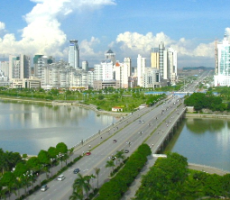Nanning is the capital of the Guangxi Autonomous Region in southwest China. It is the center of the Zhuang culture, Chinas largest minority at well over 15 million people. The city has been closely involved in relationships with neighboring Vietnam, both positive and negative, and now has an open border with Vietnam. Now a  prosperous industrial city, its mild climate allows a year-round growing season for rice, sugar-cane, and subtropical fruits such as mangos and lychees. prosperous industrial city, its mild climate allows a year-round growing season for rice, sugar-cane, and subtropical fruits such as mangos and lychees.
Nanning was the political and military center of southwestern China some 1,600 years ago, when it was beyond the control of the Chinese empire. It received its present name during the Yuan dynasty (1279-1368) when it was first subjugated by the Mongols. Nanning was a medium-sized market town until the early twentieth century, when European traders opened a river route from Wuzhou on the eastern border with Guangdong. It developed rapidly as a trans-shipment post for arms and supplies to Vietnam during the Vietnam War years, along the Nanning-Hanoi rail line. Since the 1990s the resumption of cross-border traffic has made Nanning the center of the regional trading relationships with Vietnam.
Nanning is the center of the Zhuang minority culture, and its population is more than 63% Zhuang. The Zhuang are strongly assimilated into Han Chinese culture however, with some remnant customs such as the Longboat (Dragon Boat) races held on the 5th day of the 5th lunar month (around the beginning of June).The Miao, Yao, and Dong minority cultures were more independent, and the Miao and Yao remained in the hill regions of the province in the 19th century, with several uprisings that were forcefully suppressed by the Han Chinese authorities. The Miao and Dong are noted for their traditions of silver jewelry. |
